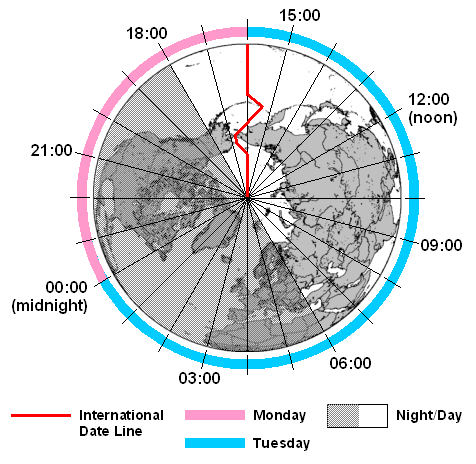Difference between revisions of "Time: Arctic"
Hunt.james (talk | contribs) m (Added Linkbox) |
|||
| Line 102: | Line 102: | ||
|} | |} | ||
| − | |||
| − | |||
[[Category:DATE]] | [[Category:DATE]] | ||
[[Category:Arctic]] | [[Category:Arctic]] | ||
[[Category:Time]] | [[Category:Time]] | ||
Revision as of 19:35, 4 January 2019
Time Overview
In most places on Earth, local time is determined by longitude, such that the time of day is more-or-less synchronized to the position of the sun in the sky (for example, at midday the sun is roughly at its highest). This line of reasoning fails at the North Pole, where the sun rises and sets only once per year, and all lines of longitude, and hence all time zones, converge. There is no permanent human presence at the North Pole and no particular time zone has been assigned. Polar expeditions may use any time zone that is convenient, such as Greenwich Mean Time, or the time zone of the country from which they departed.
Western time is based on scientific calculations and observations. From the sundial to the atomic clock, time relies on such measurements as the rotation of the earth to the number of oscillations of a particular atom. These are finite measurements of time which contrast drastically with the changeable calendar of the Sámi. The Western concept of time is not a product of experiential learning but rather a shared careful observation made by a relative minority of the population. Without a watch or clock, most Westerners would be unable to offer what they would consider an accurate estimate of the time. This is not true of Arctic indigenous peoples.
Arctic Indigenous European Peoples Concept of Time
The majority of indigenous European persons in the Arctic are the Sámi (aka Saami or Laplanders). Sámi knowledge is based on experience in that knowledge was not obtained from a book or taught in classroom, but rather it was accumulated through repeated experiences of particular situations. Sámi time is based on the cycles of nature, particularly the yearly cycle of the reindeer.
Sámi concept of seasons are based on the eight reindeer life-cycles and prevailing weather conditions.
| Season | Explanation |
| Spring-Winter | The herd begins the migration from the forests to the calving grounds in the mountains |
| Spring | The temperature increases and the snow begins to melt. Reindeer calves are born |
| Pre-Summer | The reindeer graze and the Sámi have some time to rest and prepare for the earmarking of the calves |
| Summer | Much of this season is bathed in twenty-four hour per day sunlight. During this time, earmarking takes place to denote ownership |
| Pre-Autumn | The Sámi begin to prepare for the harsh winter by choosing the bull reindeer destined for slaughter |
| Autumn | This is the season of rut. The reindeer mate prior to their return to the winter grounds |
| Pre-Winter | The herders lead the reindeer out of the mountains to the lowland bogs |
| Winter | Under a cover of twenty-four hour per day darkness, the Sámi move the reindeer to the forest, the last place to find enough food to support the herd |
The Sámi divide their year into 12 months like the Western calendar. However, these are not set by a specific number of days. They are based on natural phenomena.
To help track these times, the Sámi developed a wooden calendar in the mid-1800’s. The wooden calendar is divided in weeks and is easily transportable. Typically fabricated from wood or reindeer antler, this calendar was used to keep track of both natural phenomena and religious occurrences. Written in the runic alphabet, the wooden calendar was a useful tool in helping to preserve the balance between nature and religion as they denoted events in both realms. Crosses denote days of religious significance while fish and leaf sprigs denote various events in nature. By keeping track of time in this way, the Sámi could easily refer back to earlier times of the year in order to try to predict when the fishing season would be most bountiful or whether or not spring would arrive early or not.
| Western | Sámi | Meaning |
| January | Ođđajagemánnu | New Year Month |
| February | Guovvamánnu | Unknown |
| March | Njukčamánnu | Swan Month |
| April | Cuoŋománnu | Snow Crust Month |
| May | Miessemánnu | Reindeer Calf Month |
| June | Geassemánnu | Summer Month |
| July | Suiodnemánnu | Hay Month |
| August | Borgemánnu | Molt Month |
| September | Čakčamánnu | Fall Month |
| October | Golggotmánnu | Rut Month |
| November | Skábmamánnu | Dark-Period Month |
| December | Juovlamánnu | Yule Month |

